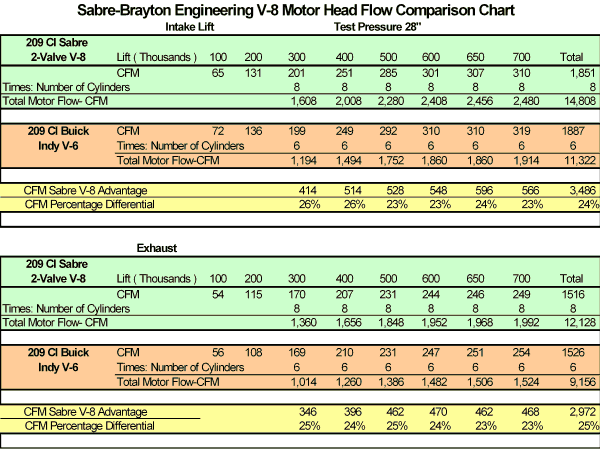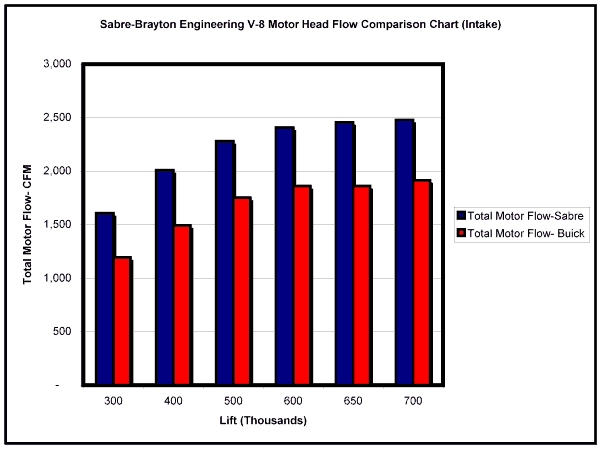| Sabre V-8 Motor Project |
|
Introduction:
In the early 1990s, Brayton Engineering was a consistent INDY 500 participant with a motor building facility and excellent driver, Scott Brayton. In 1992-93, Lee Brayton, owner of Brayton Engineering, and Roman Slobodynskyj, President of USA Race Cars, had discussions regarding a single purpose 209 C.I. INDY push rod motor advantage in INDY competition. At that time, Brayton had been running Buick V-6 motors which featured great horsepower but not great reliability for a 500 mile event. After months of research, it appeared that a superior product could be developed with a technical advantage and Brayton decided that the best gift he could give his son was a specially designed motor to race at INDY. Lee Brayton borrowed almost $2 million against his gravel business and commissioned Roman Slobodynskyj to design and oversee the project. The objective was to create a motor capable of winning INDY with over 850 HP. The design ultimately would run at 10,000 RPMs. The project began and not one single part was "off the shelf" and, therefore, every part had to be meticulously designed and crafted. The flow characteristics of every high performance motor was compared and tested and when the testing was completed, it resulted in a design that flowed approximately 25% more than the Buick V-6 currently being raced at INDY. The attached chart shows the results of those comparisons. The project was an immense undertaking which involved designing and drawing every component, making patterns and tooling, overseeing machining operations, assembly, testing and dyno development. The 72 degree block design provided for the motor to feature a single cam shaft mounted at the top of the motor block. This allowed for short push rods with roller bearings at each end. The result was very light-weight which allowed for very high revs and great reliability. The first prototype motor was assembled and the dyno testing began. The early dyno runs showed more potential than expected. Initial horsepower tests, run on alcohol and undersized turbos, demonstrated 928 HP at 10,000 RPMs. Only minor problems arose during these tests. The biggest problem was locating turbos large enough to supply the immense breathing needs of the motor. Soon after the dyno tests began, Lee Brayton invited John Menard to see the motor run on the dyno. Lee thought Menard might be interested as a customer for a few of these motors for Team Menard, since Menard primarily used the V-6 Buick for their INDY campaigns. At that time, maximum horsepower output, as reported by Lee Brayton, from the Buick race motors was approximately 800 HP. Menard was so impressed with the performance and potential of the Brayton V-8 motor, that he and Lee Brayton made a comprehensive business transaction that included purchase of the motor program and employment of Scott Brayton as a Team Menard driver. The approximate price of the motor purchase program was $2 million. Menard began his own development of the Brayton V-8 motor and adapting of the motor to the chassis used by Menard. Time ran out ( to race in the 1994 INDY 500 ) to complete the installation of the motor in the chassis due to technical reasons with Buick. Apparently, Eddie Cheever, lead driver for Team Menard, had a "Better or Best" clause in his contract to run the best motor, however, Buick sponsorship prevented the use of the Brayton motor in Scott Brayton's race car for the 1994 INDY 500. The rest is history. In April of 1994, at the Long Beach Grand Prix, Roger Penske announced that he was going to race INDY with a Mercedes "push-rod" motor. That caught all other teams flat footed with no time to develop a motor to exploit the rules. Menard was caught in a dilemma and had the only motor with a chance to beat Team Penske. In 1994, Team Penske finished the INDY 500 with a first ( Al Unser, Jr. ), second and third. It was one of the most dominated INDY races of all time. Later it was reported by Lee Brayton that the Mercedes motor peak output was about 850 HP. Team Menard had a motor with at least 75 more horsepower and could not race it for technical reasons. Scott Brayton died during an INDY practice session not long thereafter and was never able to run the motor. The following year, 1995, the INDY turbo boost rules were changed to reduce the horsepower of push rod motors so that there was no longer a technical advantage. The Mercedes and Brayton-Menard motor projects were shelved. In about 1997, Brayton re- purchased the motor program which included parts for over 10 substantially completed, but dissembled motors, and the patterns and tooling to build more. In 1999, Sabre Engineering believed that a excellent breathing push-rod-two-valve motor had a technical advantage in endurance racing and acquired the motor project from Brayton Engineering and entered a joint development program to adapt the motor to endurance racing. In 2001, the completion of the development of the motor moved to Southern California to Duttweiller Performance, a turbo race motor specialist. The development includes several alternatives The dyno results of those tests are attached hereto. |
|
Marketing Alternatives for the Sabre-Brayton V-8 Motor: | |
| 1. | Features of the motor:
The motor was designed to develop over 1,000 HP and live above 10,000 RPMs for sustained periods of time in the rigors of racing at the INDY 500. The motor weighs 322 pounds, features a head with air flow equivalent to a great four-valve race motor and has a very strong designed bottom end. The horsepower range for endurance racing, with restrictors, allow the V-8 to run under very little stress which should provide excellent reliability. The location of the cam at the top of the block allows for short-light-weight pushrods and very high RPMs. The V-8 motor appears to have a technical advantage in that the restrictors try to equate two valve vs. four valve output, however, the Sabre V-8 has equivalent cylinder head air flow as a four valve and gets a larger inlet restrictor. |
| 2. | Turbo Charged Endurance Racing:
The ALMS and Grand Am rules allow for the Sabre V-8 to be raced as a twin turbo configuration in the LMP 900 class. Horsepower is shown on the attached dyno and summary sheets. |
| 3. | Normally Aspirated V-8 for Endurance Racing:
The ALMS allows the Sabre V-8 to be run in the LMP 675 class as a normally aspirated V-8. |
| 4. | Turbo In-Line 4 Cylinder: Extrapolation of test data strongly implies that a 2- litre in-line four cylinder motor would have great potential for the LMP 675 class. This reasoning is supported by comparing weight to horsepower of the LMP900 class vs. LMP675. The assumptions are as follows: |
| Class: | LMP675 | LMP900+ |
| Kilo / Pounds | X 2.2 / 1,485 pounds | X 2.2 / 1,980 pounds |
| Est. HP | 425 / 450 / 475 | 625 / 650 / 675 |
| Est. Weight / HP | 3.94 / 3.3 / 3.13 | 3.16 / 3.05 / 2.93 |
|
The LMP 675 class has certain inherent advantages, including the following: | |
| A. Less weight equals less centrifugal force for better cornering.
B. Less weight means less tire wear. C. Less weight equals better fuel consumption. D. The Sabre V-8 Motor would work at very low stress loads for great reliability. | |
| 5. | USAC Midget Motors: Current USAC Midget motors built by Brayton Engineering produce 360 HP from 163 CI or 2.65 litres. These unrestricted motors are basically ½ of a small block 327 Chevy V-8 motor, built on an in-line special four cylinder alloy blocks with dry sump systems and run on alcohol. The racing group has found that the Chevy Small block SB-2 hear or the Ford NASCAR head performs the best to date. The motor blocks allow machining the block to accommodate running either the Ford or Chevy head. |


|
|
To Sabre Project Page 2 |





